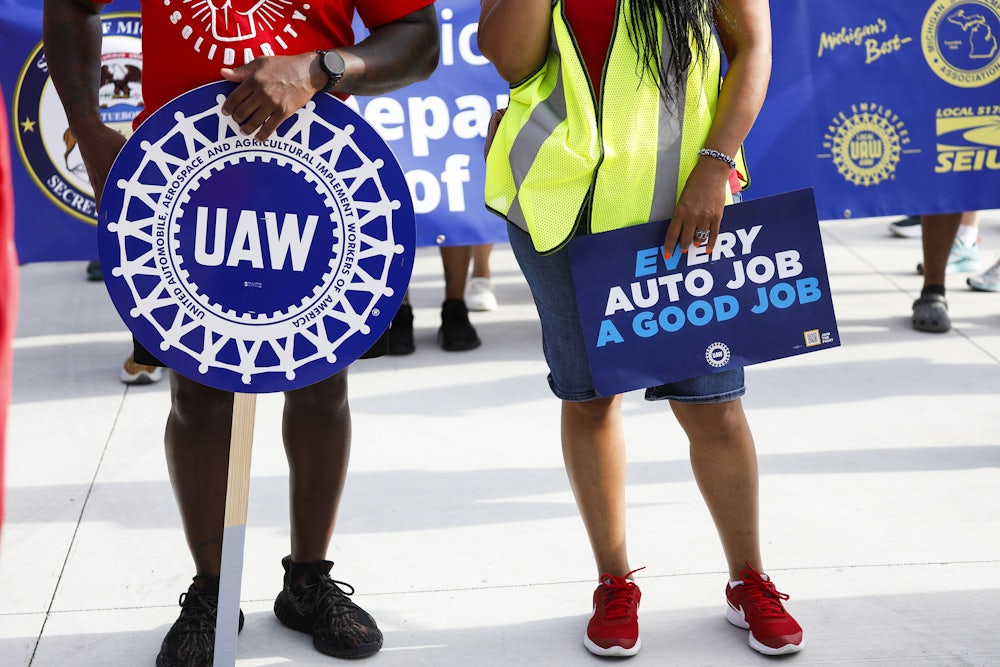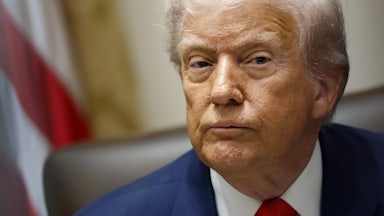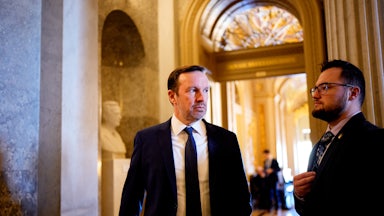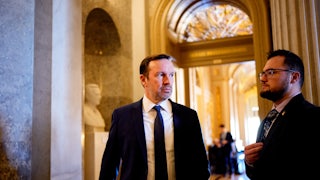With the backing of most major U.S. unions—the Teamsters were a notable exception—Kamala Harris won a majority of union households in 2024 but failed to stop Donald Trump. Union members are still likelier than non-union members to vote Democratic, but Harris’s union household support was down by three percentage points from Joe Biden’s 2020 mark; Trump’s was up by five. Nearly 40 percent of registered voters who are also union members now vote or lean Republican. As has been true for decades, the Democratic Party is hemorrhaging working-class voters, including working-class people of color.
Given Trump’s track record, there is no reason to believe that he will reward workers for their support. Like Elon Musk, he would gladly fire them all the second they crossed him. Americans were unmoved by Democratic appeals to “defend democracy” because they don’t experience much of it in their daily lives: Leaders make major policy decisions without the public’s knowledge or approval, take away rights a majority voted to keep, and fund wars a majority oppose. American workers have little to no control over their working conditions and no federally protected right to take time off. These days, even their toilet use is monitored and restricted.
These conditions explain why so many are alienated from politics—more Americans simply didn’t vote in 2024 than voted for Trump or Harris—and why working people cannot put their faith in electoral politics alone. The labor movement is the best vehicle for defending all of our rights and advancing society, and it’s even more urgent to strengthen it under Trump.
A majority of Americans support organized labor across party lines. Seventy percent approve of labor unions. A 2023 American Federation of Labor and Congress of Industrial Organizations, or AFL-CIO, poll of registered voters found that this was true of 91 percent of Democrats, 69 percent of independents, and 52 percent of Republicans. Sustainable mass movements require the broadest possible base of support, and Americans who didn’t vote or voted for Trump need labor rights, clean air and water, child care, health care, abortion rights, and paid family and sick leave, too. It is impossible to forge and win the large-scale universal programs that could improve millions of lives without a robust labor movement.
While denizens of red states live in fear of their own state governments, those in blue states can’t rely on leaders as weak and scandal-scarred as New York Governor Kathy Hochul, New York City Mayor Eric Adams, or even New Jersey Governor Phil Murphy—all of whom have cozied up to Trump—to protect them from Trump. But ordinary people still have power. Americans are democratizing their workplaces and implementing popular laws and policies, despite anti-democratic politicians who flout the popular will. The labor movement can magnify this power by remaining independent from, while strategically engaging with, the rigid two-party system most Americans have come to hate.
In recent years, workers have vented their dissatisfaction with the status quo through militant labor actions. There were roughly as many strikes in 2024 as in 2022, and nearly 460,000 workers were involved in significant workplace strikes in 2023—a 280 percent increase from the prior year. Those strikes, and sometimes just the threat of one, yielded major gains for workers, from the landmark deal the United Auto Workers, or UAW, won in 2023 to the 38 percent general wage increase over four years that Boeing machinists got after shutting down production in the Pacific Northwest, as well as the 61 percent over six years longshoremen secured after a three-day port strike in 2024.
Labor was also instrumental in retaking House seats from the GOP in 2024, especially in blue states such as New York and California. In 2023 the Working Families Party, or WFP, formed the Battleground NY coalition with left-leaning groups like Planned Parenthood and Indivisible, and unions like 1199SEIU United Healthcare Workers East, AFSCME, and Communications Workers of America District 1. Together, they raised more than $11 million, knocked on more than 800,000 doors, and flipped three New York House seats in districts outside of New York City—no small feat, given the unpopularity of New York Democrats like Governor Kathy Hochul, who is now less popular with New Yorkers than Trump.
“Folks at the door cared primarily about bread-and-butter issues,” said Hae-Lin Choi, political and legislative director at Communications Workers of America District 1. “We did a lot of message testing and had all kinds of theories about, ‘It’s all going to be about immigration, it’s going to be about crime.’ And it’s not that these issues [didn’t come up], but at the end of the day, it was really more about, ‘How do I put food on the table? I can’t afford housing here.’”
State and local races matter, too. Sarah Ganong, the WFP’s Connecticut state director, was part of a similarly successful effort to flip a number of state legislative seats in Connecticut from red to blue in 2024, even as the Democratic Party was losing support throughout the country and Trump was gaining ground in Connecticut. Despite these headwinds, public school teacher Nick Menapace beat Holly Cheeseman, a high-ranking, fiscally conservative Republican, labor activist Nick Gauthier defeated a four-term Republican incumbent, MJ Shannon won a Republican seat in West Haven, and Kaitlyn Shake, a registered nurse, flipped a seat in Fairfield County. Another nurse, Rebecca Martinez, flipped a seat in Plainville and Kenneth Gucker flipped one in Danbury. By running on improving local schools and reining in healthcare costs, Martinez won in a district that voted to send Trump back to Washington.
Several of these candidates had experience campaigning, having run and lost in previous cycles. It also helped that Connecticut has the most unionized public sector in the country and the WFP backed mostly working-class candidates—teachers, nurses, union organizers, and small business owners, as opposed to what Ganong called the “upper-middle-class white lawyer men” who typically run for office in the state. The candidates who flipped GOP seats in the last cycle, she said, have strong ties to the communities they ran in and/or are union members themselves, making it “easier for labor to jump on board and be supportive and for folks to recruit members to be volunteers and to vote for them.” While knocking on doors for Shake, Ganong met a Republican woman who turned out to be a colleague of the candidate’s. She knew Shake as a leader in their union and was “excited to vote for her because of that,” Ganong said.
How did pro-immigrant labor and progressive groups address immigration and crime without alienating the people they hoped to represent? WFP encourages candidates “not to shy away from their beliefs,” said Ganong. “Somebody might be incredibly anti-immigrant and also incredibly supportive of their local public schools,” she added, and “people respect politicians who actually say what they believe.”
Pro-worker policies are more popular than politicians. Red state voters may dislike Democrats, but they support progressive policies and labor actions. The numbers don’t lie—when popular policies are on the ballot, voters show up and get big changes passed into law. In 2024, Missouri voters approved a ballot initiative backed by a coalition of unions and religious, civil rights, and women’s organizations to raise the state’s minimum wage to $15 an hour and guarantee paid sick leave. Alaskans approved a ballot measure backed by labor groups, small businesses, and the Alaska Federation of Natives to increase the state minimum wage to $15 an hour by 2027 and to ban captive audience meetings. And voters in Nebraska approved a paid sick leave program backed by labor and progressive groups like the state AFL-CIO, state ACLU, and the Women’s Fund of Omaha by a margin of nearly three to one. The labor-backed, D.C-based Fairness Project also supported these measures.
Beyond these policy wins, support for labor is deepening throughout the country. In April, Volkswagen employees in Chattanooga, Tennessee, voted overwhelmingly to join the UAW, making it the union’s first successful organizing drive at a plant outside of Detroit’s Big Three. The teachers’ strikes that erupted in red states in 2018 attracted fervent support across the political spectrum. A survey conducted by Columbia University sociologists in the six states where teachers walked out in 2018 found that the strikes had changed attitudes, particularly among “conservatives, Republicans, and those without personal experience with unions.” The 2018 and 2019 walkouts in West Virginia were unlawful then and are, thanks to a strike-breaking law passed in 2021, clearly illegal today. But they were so popular that teachers faced no meaningful consequences for striking anyway.
In New York, organizers were able to pass the nation’s first major Green New Deal policy partly thanks to labor. The Democratic Socialists of America, or DSA, to which I belong, spearheaded the campaign to pass the Build Public Renewables Act, which empowers the New York Power Authority, or NYPA, to own and operate renewable energy projects across the state. Despite widespread popular support, organizers only got it over the finish line by bringing unions on board. The bill passed after proponents extracted a hard-won promise of neutrality from major unions like the AFL-CIO, which ultimately wrote the bill’s labor language.
Hundreds attended a November NYPA hearing at the John Jay College of Criminal Justice in Manhattan to demand that the agency generate enough public renewable energy to comply with state law. Many were members of the Professional Staff Congress, which represents faculty and staff at the City University of New York, the United Federation of Teachers, or UFT, and/or DSA. A 14-year-old girl with asthma testified that she used to hold her breath as she walked by smokestacks on her way to school, hoping it might make breathing easier in the long term. Trump had been reelected a couple of weeks earlier. People were anxious, frightened, and furious with the state’s Democratic leaders. Several speakers broke down in tears. Teenagers testified that their entire lives had been shaped by the climate crisis. As one law student put it, “No one is coming to save us.”
This is an increasingly common sentiment as Trump’s second term unfolds, and it’s spurring a new phase of DIY resistance. Anger at Democratic Party leadership for failing to protect the country from Trump is widespread, as is hunger for a more democratic, militant, and effective labor movement. In recent years, rank and file union members have defied and challenged their union leaders throughout the country. Reform caucuses such as the UAW’s Unite All Workers for Democracy, Teamsters for a Democratic Union, and the UFT’s Movement of Rank and File Educators have expanded, and, in some cases, seized power. The Alliance of Retired and In Service Educators, a coalition of three opposition caucuses within the UFT, recently announced that it will run Olivia Swisher—a chapter leader and self-described “army brat”—against longtime UFT President Michael Mulgrew in the union’s spring elections.
Progressive unions, community groups, and political organizations are driving this push to reform major unions and increase the number of unionized workplaces. As part of an effort to improve pandemic-era working conditions, DSA partnered with the United Electrical, Radio and Machine Workers of America to form the Emergency Workplace Organizing Committee, or EWOC, which supports workers who want to build a union and/or fight collectively for better working conditions. EWOC has since helped organize a number of workplaces, including Barboncino, which became the first unionized pizzeria in New York City in 2023.
DSA members also helped support the 2023 Writers Guild of America and SAG-AFTRA pickets and the 2024 and 2025 Starbucks Workers United, or SWU, and IBT-Amazon Labor Union pickets. At a January strike at a Starbucks store in Park Slope, Brooklyn, the NYPD arrested seven people for staging a sit-in. Members of the New York Hotel Trades Council and 32BJ SEIU, community members, DSA members, and local Democratic politicians stood with the workers. Starbucks has shuttered a number of locations that voted to unionize. The day of the arrests, Starbucks CEO Brian Niccol said he plans to double the number of stores in the U.S.; three days later, the company shut down its Park Slope location. SWU and Starbucks recently announced that they were bringing in a mediator as part of a push to revive stalled contract talks.
Olivia Gonzalez Killingsworth sits on DSA’s National Labor Commission steering committee and NYC DSA’s Citywide Leadership Committee and cochairs the branch’s Labor Working Group. She has been a member of both SAG-AFTRA and the Actors’ Equity Association for nearly 20 years. She sees DSA and organized labor as aligned on several key fights at the dawn of Trump 2.0. The push to implement the BPRA is one, and DSA’s backing of a Social Housing Authority bill in Albany is another. Killingsworth believes the fact that the building trades and the UFT have warmed to the housing bill “reflects that organized labor now sees us supporting and passing policies and getting things done that can actually help their members and create jobs for their members—and not just better pay, but better working and living conditions.”
DSA is seeking to build alliances with workers and unions across ideological lines. Harold Daggett, head of the International Longshoremen’s Association’s, or ILA, has called Trump a great friend of organized labor and a “champion of the working men and women of this country.” DSA supported an ILA-led dockworkers’ strike in 2024 while strongly opposing Trump. These relationships, while new and fragile, have emerged in part because DSA discourages its members from “proselytizing” on the picket line. DSA and the ILA have also discovered a common enemy. The ILA hates the Danish shipping company Maersk for threatening jobs by automating port operations, and pro-Palestine activists, including DSA members, hate Maersk for shipping military cargo to support Israel’s genocide. Cementing an alliance, Killingsworth said, is “a long-term building project in the same way that it took us years and years and years on the left and in the labor movement to build towards an anti-apartheid movement in South Africa.”
For Killingsworth, whose grandfather was an undocumented manual laborer, solidarity with immigrants is a key component of solidarity with labor. “People’s food wouldn’t have made it to their tables without guys like my granddad working in the fields,” she said. “We can’t afford to ignore our immigrant neighbors, whether they have papers or not.”
On a frigid day in January, I attended a Manhattan rally in support of Atlantic Theater Company production workers who had voted to unionize with the International Alliance of Theatrical Stage Employees, or IATSE, in February 2024. A few days after the rally, they went on strike. An “extreme cold” advisory was in effect, but when I arrived, I could hear chanting and cheering from several blocks away. “You look beautiful out here in the cold!” boomed one of the speakers. The crowd roared back in approval.
The rallygoers had different takes on the challenges labor is facing. Lou Shapiro, a retired union stagehand, his wife Susan, and their bear-like dog Phoebe had braved the cold to show solidarity. Shapiro thought the Teamsters were wrong not to endorse Harris in the presidential election (they didn’t endorse Trump, either, despite claiming that 60 percent of their members wanted them to). Had the Teamsters backed Harris, Shapiro said, they might have spared the country another four years of Trump. Veteran labor and racial justice activist Bill Fletcher Jr. shares this view. In a phone conversation, he questioned the Teamsters’ polling results and said failing to endorse Harris was “horrific with a capital ‘H’” and a betrayal of the broader labor movement.
But Charlie Dibe, a longtime union member and Communist Party USA organizer in the film industry, approved of the Teamsters’ decision. In a phone conversation, he said that when it comes to endorsements, unions should “leverage their power” and be “responsive” to their members. To younger people like Allison, an actor and SAG-AFTRA member who preferred not to share her last name, Trump was almost beside the point. The politicians who run New York, she said, represent the “capitalist class”—and workers have their own interests, which are opposed to those of the capitalists.
“Every worker … deserves a thriving wage, access to healthcare, a retirement with dignity, and the ability to plan for their family’s future—no matter what this administration or any other administration says,” said Natalie Robin, an organizer with IATSE Local USA 829. Mikey Stevens, an Atlantic Theater worker who spoke at the rally—he was about to turn 28 and had been without health insurance for two years—said that labor organizing would be harder under Trump, but no less necessary. “Workers have always had power, and it doesn’t come from the government,” he said. “It comes from the fact that we are the ones who make things happen.”
By appointing labor champions like former General Counsel Jennifer Abruzzo to the National Labor Relations Board, or NLRB, Biden, once dubbed the most pro-union president since FDR, helped spur major gains in labor law and policy. Trump fired Abruzzo and her colleague Gwynne Wilcox in January, depriving the NLRB of a quorum and impeding its ability to function as a national body. Wilcox is now suing Trump for violating the National Labor Relations Act. But even under Biden, workers could not rely solely on existing laws, agencies, or courts to protect or enforce their rights—of the five hundred Starbucks locations that have voted to unionize as of October, none has won a union contract (some Starbucks kiosks in grocery stores, airports, and other locations operate under union contracts with the larger venue). The Supreme Court’s right-wing majority and corporate benefactors are pushing to cripple federal regulatory agencies via constitutional challenges filed in conservative courts.
The NLRB has a new Acting General Counsel, and much of its work can be carried out by its regional offices. But given Trump’s attack on federal agencies, workers must now, as Abruzzo urged after her ouster, “take matters into their own hands.” Jessica Rutter, who served in the General Counsel’s office under Biden and was also fired by Trump, said that going forward, “workers will continue to build power, whether or not they can rely on the same tools.” And Rutgers University assistant professor of labor studies Eric Blanc has argued that unions now have the “opening and responsibility to fill the political vacuum created by the Democratic Party’s disarray,” and “take their rightful place as the best defenders of working people and political democracy.”
“People are yearning to leave the transactional service model unionism for a union that really feels like it’s got your back,” said Swisher of ARISE, adding, “That should be a model for all workplaces right now.” Trump has his mandate, however slender. And workers have theirs.










